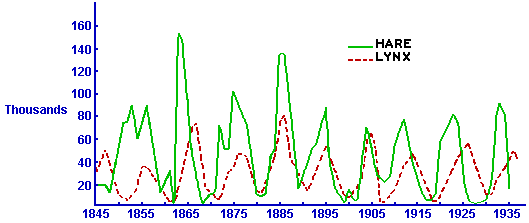The Canada Lynx by Lauren Danna
November 10th, 2017
| Image 1: http://mentalfloss.com/article/33677/canada-lynx-ghost-cat-north |
Description and Ecology
Although this animal may look like another pet cat, just a bit bigger and fluffier, that your 7 year old self (or at least my 7 year old self) would just want to cuddle with on the couch at home, it is quite the opposite. Weighing in at 18-23 pounds, the Canada lynx (Image 1) is
a medium-sized cat that measures to about 75-90 centimeters in length. The lynx
call home to cold, snow covered forests and because of this have bodies that
are adapted for that terrain. They have large feet that act as snow shoes to
walk on the snow. They also have long legs, black-tipped tails and tufts on
their ears that make hunting their prey in the snow easier. The primary prey of
the lynx is the snowshoe hare. Since lynx population positivity is positively
related to the density of snowshoe hare (refer to image 5) within its range they both inhabit
similar areas, conifer and conifer-hardwood habitats. These habitats have very cold and long winters and contain a combination of tree types including spruce,
| Image 2: Boreal Forst http://borealforestfacts.com/?p=234 |
fir, larch, pine, aspen, birch, and poplar.
Geographic and Population Changes
1 The Lynx required habitats range across different parts of the United States along with Canada and Alaska. The Lynx in the US are supported by the
Boreal Forest. This forest is home to Canada but has southernmorst ranges in the
Northeast, Great Lakes, Rockies and Cascade Mountains. The lynx has been
recorded having appeared in the 14 US states that support the boreal forest. Some important findings by the FWS show that lynx populations in the U.S. are influenced by the lynx populations in Canada, some populations even having a direct connection. The FWS has also observed that some Canadian lynx populations are a source of emigration for lynx populations in the contiguous United States. Due to these findings, it is important to continue the connection between the contiguous United States and Canada to ensure long-term persistence of lynx populations in the United States.
| Image 3: Map of Lynx Population http://darwinslist.com/mammals/canada-lynx/ |
Listing Date and Type
The Lynx was listed on March 24th, 2000 by the U.S. Fish and Wildlife Service. The Lynx is an endangered species and was categorized as "threatened".
Cause of Listing and Main Threats
 |
| Image 4: Timber Harvesting https://commons.wikimedia.org/wiki/File:Timber_harvesting_in_Kielder_Forest.JPG |
The FWS constructed a plan for the lynx around the identified core areas and the protection of them. Specific objectives produced by the FWS include:
- Retain adequate of sufficient quality to support the long-term persistence of lynx populations within each of the identified core areas.
- Ensure that sufficient habitat is available to accommodate the long-term persistence of immigration and emigration between each core area and adjacent populations in Canada or secondary areas in the United States.
- Ensure that habitat in secondary areas remians available for continued occupancy by lynx.
- Ensure that threats have been addressed so that lynx populations will persist in the contiguous United States for at least the next 100 years.
Recovery for the Lynx is considered achieved once conditions have been met that allow lynx populations to exist long-term within each identified core area.

https://services.math.duke.edu/education/webfeats/Word2HTML/Predator.html
What can YOU do??
If you're wondering if you can help these these animals you can! Some things you can do to help out are
- Donate money
- Adopt a lynx symbolically
- Send a message to government leaders expressing your concern
- Speak up for wildlife
- Sign up to receive instant alerts and updates about important issues affecting wildlife through Defenders of Wildlife
- Become a Defender of wildlife by obtaining a Defenders membership through Defenders of Wildlife
Other Resources
To learn more about the lynx and ways you can help out visit these sites! Listed below are just a couple of the many sites. You can find more by completing a search on the web.
 |
| Image 6: Canadian Lynx https://goo.gl/images/g5HjtQ |
Bibliography
All information was sourced from the Canada Lynx Recovery Plan
U.S. Fish and Wildlife Service. 2005.Recovery Outline for the Contiguous United States Distinct Population Segment of Canada Lynx (Lynx canadensis). U.S. Fish and Wildlife Service
It was interesting to see that the main threat facing the Canada lynx is the harvest for timber. It was a good point for the recovery plan to acknowledge that the secondary habitat for the lynx remain available.
ReplyDelete-Marina Enriquez
ReplyDeleteThis comment has been removed by the author.
ReplyDeleteI found it interesting that the range of the lynx extends so far into the United States. I hope that this species will be able to adapt to global climate change.
ReplyDelete- Kyla Cooper
I can understand how logging can severely affect a species. It's sad to see that the human demand for timber directly affects the decrease in the Canada Lynx populations.
ReplyDelete-Erika DiLeva